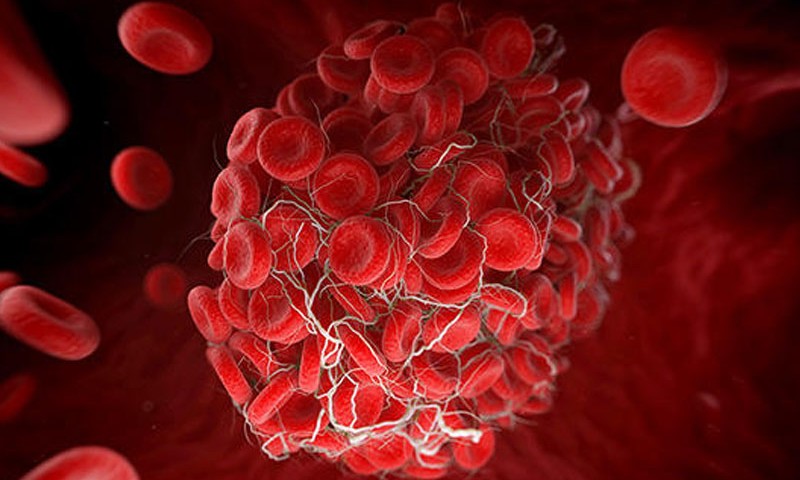10 Things That Can Up Your Risk For Blood Clots
You know blood clots are scary, and you know you don’t want one, but what exactly are they, and who’s at risk?
Put simply, your blood is a liquid, and when it hardens into a solid, that’s considered a blood clot. And there are a few different types: A blood clot that forms in the deep vessels of the lower extremities, like your legs, may lead to a deep vein thrombosis (DVT). If this kind of blood clot dislodges and travels to the lungs, it may cause a pulmonary embolism (PE), which can be deadly because it impairs blood flow and oxygen to the lungs. “The risk of death is real, especially if these clots are left untreated,” says Nesochi Okeke-Igbokwe, MD, an internal medicine physician at NYU Langone Medical Center. “It’s important for patients to recognize the signs and symptoms of DVT and PE in order to get early diagnosis and treatment.”
“Approximately one-third of patients with symptomatic DVTs develop a PE; death occurs in about 6% of DVT cases and 12% of PE cases within 1 month of diagnosis,” says Glenn Harnett, MD, chief medical officer for American Family Care, which has family care/urgent care clinics Alabama, Tennessee, Georgia, and Florida.
To keep clots at bay, it’s important to know the risk factors. (Want to pick up some healthier habits? Sign up to get daily healthy living tips and more delivered straight to your inbox!) Here are 10 common ones.
Sitting for a long period of time

This can be while traveling on a plane, driving or riding in a car, or spending long periods of time in front of a computer at work or home. “It’s imperative to get up and move around every 30 or 40 minutes. Using your leg muscles helps keep your venous blood flowing. Flexing and extending your foot can help as well,” says Harnett. (Try these stretches if you sit all day.) And while sitting for long periods of time is a problem no matter if you are in a car, on a plane, or at a desk, says Harnett, plane seats can be especially constricting because they’re narrow and short on leg room.
Pregnancy

“The extra estrogen that circulates in the body during pregnancy may contribute to an increase in the amount of clotting factors, resulting in a higher risk of blood clots,” says Okeke-Igbokwe. Additionally, pregnancy increases the pressure in your pelvic and leg veins. “The risk for blood clots from pregnancy can continue for up to 6 weeks after giving birth,” says Harnett. So, keep moving—walking, prenatal yoga, and other exercises—both during pregnancy and after your little one is born.
Your height and weight
Obesity puts you at a higher risk for DVT due to decreased mobility as well as poor circulation, says Harnett. It’s just one more reason to maintain a healthy body mass index (between 18.5 and 24.9). Also, many people don’t know that height plays a role. “Women over 5’6″ and men over 6′ are at higher risk for clots,” says Harnett. “The taller you are, the farther your blood needs to travel against the force of gravity, and with any kind of decreased circulation, the blood can pool, leading to an increased risk of clotting.”
Having an irregular heartbeat
You may not know you have one—in many cases, there are no symptoms of an irregular heartbeat and it often goes undetected—but it does increase your risk for blood clots. “Atrial fibrillation is a kind of irregular heart rhythm that can put you at increased risk of blood clot formation in the upper chambers of the heart,” says Okeke-Igbokwe. That’s because the irregular beating may hinder blood from being thoroughly pumped into the ventricles. Blood can become sluggish and start to pool in the upper chamber, potentially leading to the formation of clots.” This type of clot may travel to the brain and cause a stroke.
Birth control pills

“Estrogen and progestin in certain oral contraceptives may also increase the concentration of blood-clotting factors,” says Okeke-Igbokwe. Likewise, some hormone therapies may increase clot risk. Talk to your ob-gyn about the risks to make sure you’re on the right medication, given your medical history.
Cancer
“Some forms of cancer increase the amount of substances in your blood that cause clotting,” says Harnett. According to research detailed in The Surgeon General’s Call to Action to Prevent Deep Vein Thrombosis and Pulmonary Embolism, people with cancers of the brain, ovary, pancreas, colon, stomach, lung, and kidney have the highest risk of DVT. Also, some forms of chemotherapy and cancer prevention medication also increase chances of DVT. “It’s not well known why chemotherapy increases risk of DVT, but it is suspected that this could be because it causes damage to blood vessels or reduces the production of proteins that protect from clots,” says Harnett. Damaged blood vessels release pro-clotting substances that can cause the blood to aggregate and form clots.
Smoking

“Certain chemicals in cigarette smoke may cause blood vessel damage, leading to an increased risk of DVT,” says Okeke-Igbokwe. If you’re currently a smoker, get into a cessation program to help curb—and ultimately stop—the habit.
Time under the knife
Major surgery, particularly to your hip, lower abdomen, or leg, ups your risk of DVT, says Harnett, since it will render you temporarily immobile. Additionally, any major trauma or injury to the legs can increase the risk of blood vessel injury, leading to the production of blood clots, notes Okeke-Igbokwe.
Your family history
Some people inherit a disorder (such as Factor V Leiden) that makes their blood clot more easily. According to Mayo Clinic research, this condition may not cause problems unless combined with one or more other risk factors. Many people do not know they have these disorders until they have already developed a DVT, says Harnett. Other conditions that may increase the risk of blood clots include certain kidney diseases, antiphospholipid syndrome (an autoimmune condition), and problems in the inferior vena cava (the large vein carrying blood from the lower body to the heart). Inherited genetic disorders such as dysfibrinogenemia, protein C deficiency, and protein S deficiency can also predispose you to develop blood clots, says Okeke-Igbokwe.
Your age
While DVT can occur at any age, the older you are, the higher your risk. “Being over 60 can up your chances of a clot,” says Harnett. “Approximately 1 in every 1,000 people will develop a DVT or PE each year, and this increases from about 1 in 10,000 for those in their 20s to about 5 in 1,000 for those in their 70s.” While aging is a natural process, be sure to check in regularly with your doctor and make sure you’re eating right, exercising, and living a healthy lifestyle.
Learn more at Prevention

